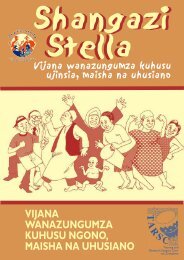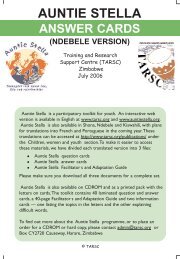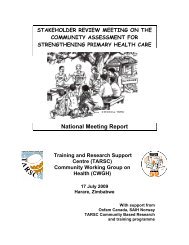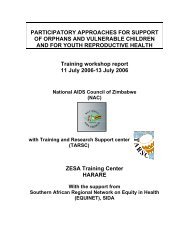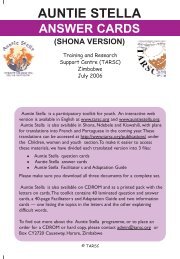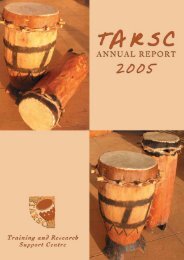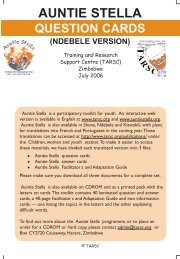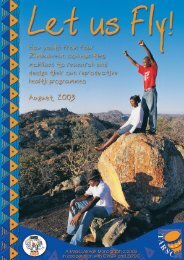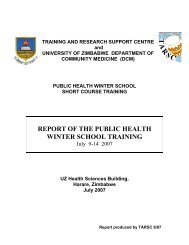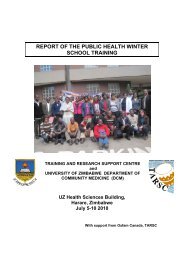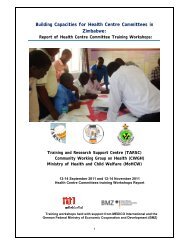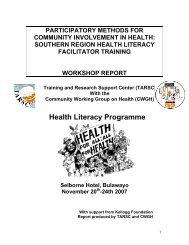BEAM rep final.pdf - Training and Research Support Centre
BEAM rep final.pdf - Training and Research Support Centre
BEAM rep final.pdf - Training and Research Support Centre
Create successful ePaper yourself
Turn your PDF publications into a flip-book with our unique Google optimized e-Paper software.
Table 1: Selected vulnerability statistics by Province, MIMS 2009, Zimbabwe<br />
Indicators<br />
Province<br />
Percentage of<br />
Children of Primary<br />
School Age (6-12<br />
Years) Attending<br />
Primary School,<br />
Total NAR;<br />
N=10,214<br />
Percentage of<br />
children of school<br />
going age citing<br />
financial constrains as<br />
a reason for not going<br />
to school<br />
N=369<br />
Percentage of<br />
children aged 0-17<br />
years who are<br />
orphaned or<br />
vulnerable:<br />
Vulnerable children<br />
N=25,804<br />
Percentage of<br />
vulnerable children<br />
aged 0-17 years<br />
not receiving any<br />
Free Basic<br />
External <strong>Support</strong> 2<br />
N=9,445<br />
Manical<strong>and</strong> 93.7 * 18.7 66.5<br />
Mashonal<strong>and</strong> Central 84.4 * 18.1 80.7<br />
Mashonal<strong>and</strong> East 90.9 75.3 13.8 82.7<br />
Mashonal<strong>and</strong> West 82.2 68.9 23.5 81.5<br />
Matabelel<strong>and</strong> North 90.2 74.4 18.2 81.6<br />
Matabelel<strong>and</strong> South 92.9 76.5 17.0 83.5<br />
Midl<strong>and</strong>s 91.2 51.9 20.2 74.4<br />
Masvingo 94.0 79.4 18.5 79.8<br />
Harare 93.7 * 14.1 88.6<br />
Bulawayo 96.7 60.3 21.3 85.7<br />
Area<br />
Urban 94.4 60.2 15.6 86.9<br />
Rural 90.1 72.8 19.2 76.9<br />
1. External support included medical, emotional <strong>and</strong> psychosocial, social <strong>and</strong> material, educational <strong>and</strong> any other<br />
support from government, private sector, religious organisations, charity <strong>and</strong> community based mechanisms.<br />
(*) Number was negligible <strong>and</strong> was suppressed, NAR: Net Attendance Ratio, Source: MIMS Zimbabwe, 2009<br />
The Basic Education Assistance Module (<strong>BEAM</strong>) is one of the important pro-poor funds that<br />
are meant for the marginalised communities in Zimbabwe. <strong>BEAM</strong> is essentially a school fee,<br />
examination fees, levies <strong>and</strong> building assistance programme that was introduced by the<br />
Government of Zimbabwe in 2001 with some initial financial assistance from the World Bank as<br />
an educational funding component of the programme for poverty alleviation. It is implemented<br />
in all the 61 districts of the country both urban <strong>and</strong> rural. It targets the vulnerable children who<br />
are aged between 6 -19 years who are in school but unable to pay schools fees, or vulnerable<br />
children who have dropped out of school or who have never been to school (Government of<br />
Zimbabwe, 2001; 2005).<br />
<strong>BEAM</strong> is administered by the Social Dimensions Fund (SDF) in the Ministry of Labour <strong>and</strong><br />
Social Welfare (MoLSW), while the Ministry of Education, Sports, Arts <strong>and</strong> Culture does the<br />
implementation under a memor<strong>and</strong>um of underst<strong>and</strong>ing signed by the two ministries. At the<br />
local level the implementation of <strong>BEAM</strong> is done by local stakeholders that include the local<br />
authorities, District Education Officers, school authorities, communities that participate in<br />
school selection committees, School Development Associations, Non-Governmental<br />
Organisations (NGOs) <strong>and</strong> Faith Based Organisations (FBOs). Implementation of the <strong>BEAM</strong><br />
programme is done through a set of terms of reference that are laid out in the <strong>BEAM</strong> manual.<br />
The <strong>BEAM</strong> programme has generally been under funded from the treasury since its inception<br />
as a result of the country’s constrained fiscal space, creating a number of operational<br />
challenges especially for schools that have a larger share of beneficiaries that solely rely on<br />
those funds. Of the estimated 3.6 million children of school going age (primary <strong>and</strong> secondary),<br />
approximately 1 million of them are in need of the assistance according to the 2011 <strong>BEAM</strong><br />
evaluation <strong>rep</strong>ort; with the Zimbabwe Early Learning Assessment (ZELA) estimating that about<br />
8



